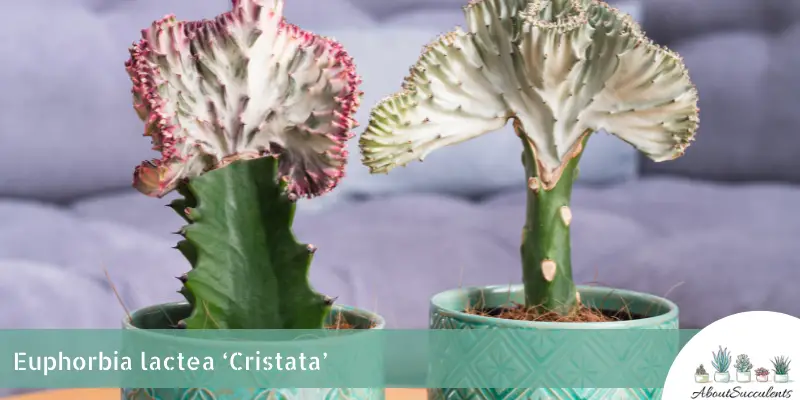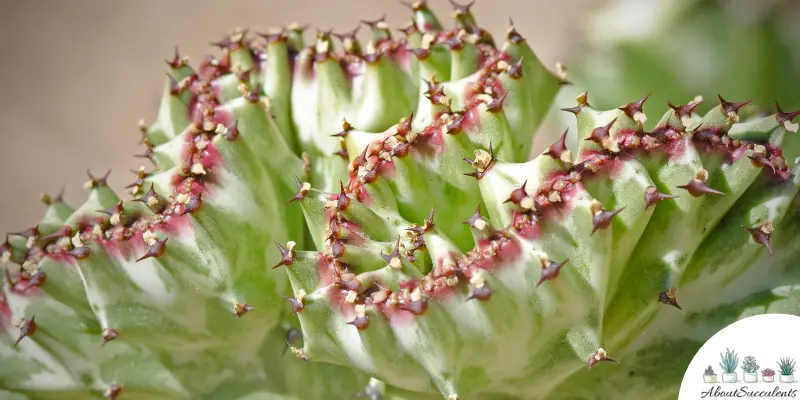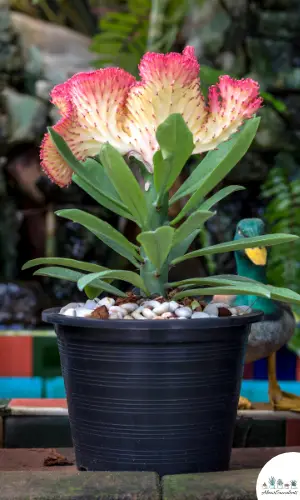
Euphorbia lactea “Cristata” strikes onlookers as peculiar. The word “Cristata” means crested and refers to Euphorbia’s wavy, fan-shaped stems that vary in color from green to blue-gray to silver.
The stems grow into an irregular shape and have an appearance similar to corals that are found in an ocean. When given proper sun, the edges of the crests turn pink.
Often mistaken for a cactus, Cristata is a combination of 2 succulent plants that were grafted together – Euphorbia lactea’s crest onto Euphorbia neriifolia’s root and stock.
The crested stems of Cristata are distinguished by rows of tiny spines and unique ivory markings. During spring, you’ll see small, green-colored flowers emerge within the vicinity of the spines.
Euphorbia lactea Cristata goes by multiple common names such as “Coral Cactus”, “Crested Candelabra Plant”, “Crested Euphorbia”, “Candelabra Plant”, and “Crested Elkhorn”.
Coral Cactus can reach a height of 36-inches (91.44cm) and a width of 24-inches (60.96cm). Cristata belongs to the genus Euphorbia which has its origins in Africa. However, Coral Cactus has been seen in Sri Lanka, India, and Thailand. It is a member of the Euphorbiaceae family.
General Information
Also known as: “Coral Cactus”, “Crested Candelabra Plant”, “Crested Euphorbia”, “Candelabra Plant”, and “Crested Elkhorn”.
Plant Family: Euphorbiaceae
Origin: Grafted from Euphorbia lactea (crest) and Euphorbia neriifolia (root and stock).
Height: 36-inches (91cm)
Exposure: Sunlight exposure for up to 6 hours per day; partial or full will do but avoid the afternoon sun.
Water Needs: Drought-tolerant; water only when the soil is 100% dry.
Soil Type: Cactus, sandy or succulent soil mix will do. You can also prepare 2 parts of potting soil mixed with 1 part perlite, pumice, coarse sand, or lava rocks.
Soil pH: 6.1 to 7.8
How to Grow and Care for Euphorbia Lactea “Cristata”

Euphorbia lactea Cristata can be grown outdoors or indoors. There are 2 things that you need to know about this succulent plant to make it easier to grow and care for.
First, the Coral Cactus is not a cold-hardy succulent. If the temperature in your region experiences drops in mercury below 20° F (-6.7° C), it would be best to plant it in a pot that you can move indoors.
Second, is that Crested Elkhorn contains a milky white sap that can be toxic to humans and pets.
If you decide to grow Euphorbia lactea Cristata indoors, place it in a location that can’t be accessed by your pet. Also, when handling the plant, wear a pair of gloves to protect your skin in case a part of Coral Plant is damaged.
Sunlight
Euphorbia lactea Cristata needs to get up to 6 hours of sun every day. It will do well with partial or full sunlight just avoid exposing the succulent to the intense heat of the afternoon sun because its stems can burn.
Look for a location in the garden that receives a lot of morning sunlight. If this isn’t possible, put Coral Cactus in an area that offers partial shade. You can also plant Cristata in a pot and place it in a location where it can get sunlight in the morning then, relocate it to an area with partial shade.
Sunlight is equally important for indoor succulent plants. Place Crested Candelabra Plant near a window that brings in partial sunlight. Another option is to place the succulent under a Grow Light.
Watering

Unlike sunlight, Euphorbia lactea Cristata doesn’t need much water. Don’t water the soil until it’s 100 % dry otherwise, you will put Coral Cactus’ roots at the risk of rotting.
Soil that’s kept moist too long will become a breeding ground for bacteria and fungi growth. The best approach for watering Cristata is the “Soak and Dry” method.
First, insert a stick an inch deep into the soil. Pull out the stick and if it feels dry to the touch, then proceed to the next step – give the soil a good soaking.
Keep that in mind – water the soil. Don’t water the plant directly because it will cause Cristata to hold on to moisture longer.
Expect to water Euphorbia lactea Cristata every seven to 10 days in the summer and spring and less during winter when the soil tends to retain moisture longer.
Pot and Soil
By now you’ve figured out that keeping the soil dry as quickly as possible is the key to maintaining the health of Euphorbia lactea Cristata.
Thus, when shopping for Coral Cactus’ home, choose between unglazed ceramic or terracotta because these materials easily absorb moisture and release them along the sides of the pot.
Find a pot that’s slightly larger than the base of the plant because Crested Elkhorn is an aggressive grower and its roots need space to stretch out in the soil. Lastly, make sure the pot has a drain hole at the bottom to allow excess water to trickle out of the soil.
Plant Crested Euphorbia in well-draining soil such as cactus or one that’s specially formulated for succulent plants. You can also create a blend of 2 parts potting soil with 1 part perlite, pumice, lava rocks, or coarse sand to improve drainage.
How to Propagate Euphorbia Lactea “Cristata”
Growing and caring for Euphorbia lactea Cristata is easy. Propagating the species is not.
In order to propagate Coral Cactus, you have to graft the crest of Euphorbia lactea onto Euphorbia’s neriifolia’s rootstock. You can also use the rootstock of Euphorbia canariensis.
If you plan on propagating Crested Candelabra Plant, you have to do it in the summertime when the succulents are actively growing. Don’t forget to wear gloves and goggles during the propagation process to protect yourself from the toxic sap.
Grafting Method
Step 1: Choose a healthy rootstock.
Step 2: With a sterilized knife, cut a “V’ on top of Euphorbia neriifolia.
Step 3: Trim the crested stems of Euphorbia lactea.
Step 4: Use a butcher’s string or twine to secure the 2 Euphorbias together and plant it on cactus, sandy, or succulent soil.
Step 5: Place the grafted Euphorbia lactea Cristata in a warm room that gets up to 6 hours of partial sunlight every day. Keep the plant in this room for several weeks or until the wounds from the grafting process have healed.
Step 6: Water the soil only when it has gone completely dry.
Frequently Asked Questions
Is Euphorbia Lactea “Cristata” Toxic to Cats and Dogs?
Yes, Euphorbia lactea Cristata is a combination of Euphorbia lactea and Euphorbia neriifolia and the genus Euphorbia is mentioned on the website of the American Society for the Prevention of Cruelty to Animals (ASPCA) as toxic to animals.
Why Is My Euphorbia Lactea “Cristata” Dying?
The leading cause of death of Euphorbia lactea Cristata is overwatering which leads to root rot.
Having pests living in your plant will also make Cristata sick because its sap will be drained and the insects will leave behind white, waxy substances that can lead to fungal infection.
To save your plant, you must act right away when you see the signs of infection.
Overwatering
If you notice the stems looking mushy or the appearance of yellow-blackish spots, reach out for a pair of garden shears or a sharp knife. Mushiness and discoloration are clear signs that an infection is taking place.
Sterilize the cutting tool with 70% isopropyl alcohol. Cut off the infected sections of the plant to prevent the infection from spreading. Uproot the plant from the soil and cut off all of the roots that have turned rotten.
Refill a new pot with fresh succulent soil. Wait for Coral Cactus to dry out before repotting. After you’re planted Cristata in its new home, wait for 2 to 3 more days before watering the soil.
Pest Infestation
Mealybugs, aphids, red spiders, and scale insects love to freeload off Euphorbia lactea Cristata.
Wipe the white, waxy substances off the stems with a cotton ball soaked in 70% isopropyl alcohol. Then, spray the plant with a natural, diluted insecticide such as neem oil to keep pests out of its stems.
Yes. Euphorbia lactea Cristata produces small, green-colored flowers in the summertime.
Last Updated on June 15, 2022 by Sofia Lara